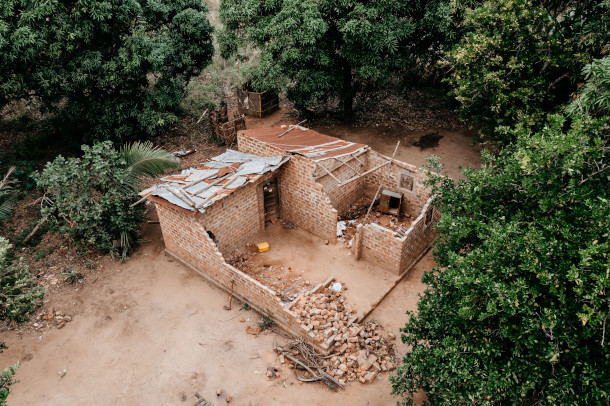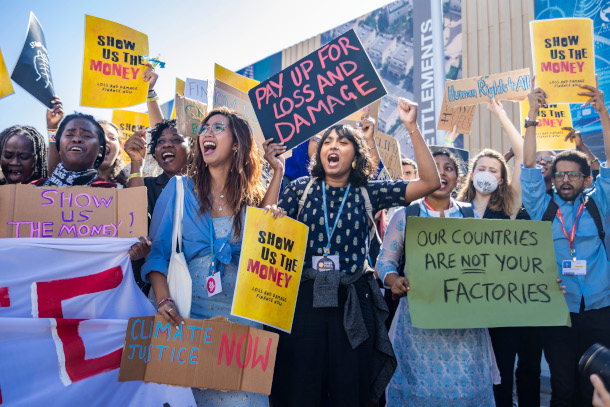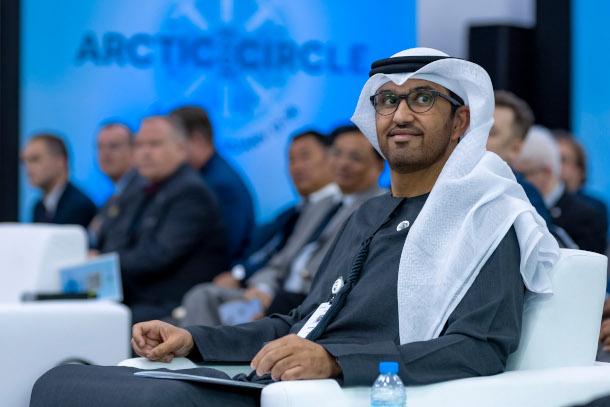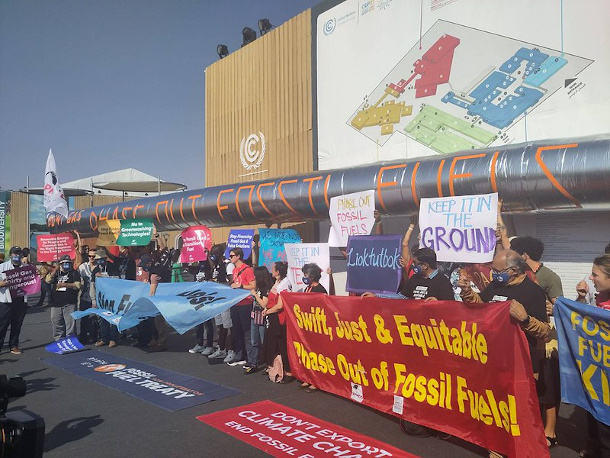Rift Over Loss and Damage
Air Date: Week of October 27, 2023

Tropical Cyclone Freddy, one of many natural disasters likely influenced by climate change, hit the developing country of Mozambique in the spring of 2022 and destroyed many homes. (Photo: Mbuto Machili, Global Partnership for Education, Flickr, CC BY-NC-ND 2.0)
Wealthy nations have agreed to pay low-income countries for some of the loss and damage caused by the climate crisis. But rich and poor nations are still divided on key elements of the fund with just a few weeks to go before COP 28. Bob Berwyn, a journalist with Inside Climate News, joins Host Jenni Doering to explain.
Transcript
CURWOOD: From PRX and the Jennifer and Ted Stanley Studios at the University of Massachusetts Boston, this is Living on Earth. I’m Steve Curwood.
DOERING: And I’m Jenni Doering.
Wealthy nations agreed at the annual UN climate conference last year, COP 27, to pay low-income countries for some of the loss and damage caused by the climate crisis. It’s a huge toll and growing. According to a May 2023 report from the World Meteorological Organization, extreme weather and climate-related events over the last 50 years caused a whopping 4.3 trillion dollars in economic losses worldwide. And even just one disaster can wipe out a small nation’s financial reserves. That’s what happened in the small Pacific Island nation of Vanuatu, which in 2020 suffered a cyclone that caused $600 million in damage, some 60 percent of its GDP. And as temperatures and sea levels rise in the coming decades, those kinds of losses are expected to keep rising too. But coming to an agreement about exactly how the new loss and damage fund should work is a bone of contention between the rich and poor nations, even as the next big climate talks this December rapidly approach. Bob Berwyn, a journalist with Inside Climate News, is here to give us some insight. Welcome to Living on Earth, Bob!
BERWYN: It's great to be here again. Thanks for having me.
DOERING: So what are the challenges the UN is facing when it comes to following through on the loss and damage commitments made last year.
BERWYN: The challenges are many. There are some serious rifts between developed countries and developing countries as to where the loss and damage fund should be hosted. They're running out of time with COP28 coming up. They had set a timetable to have finalized a set of recommendations for this loss and damage fund in time for approval at COP28. And so they held a series of meetings over the last eight months or so. And they weren't able to finalize those recommendations. So they added another sort of an extra fifth meeting of this transitional committee, as it's called, for early November, to make one more effort to finalize the set of recommendations. And the recommendations will include things like which countries should pay into the fund, which countries will be eligible to receive it, how the board of directors will be set up and again, importantly, where this fund will be hosted. Will it be hosted under the World Bank, as developed countries suggest? Or will it be sort of a more independent financial institution associated with the United Nations?
DOERING: So tell me more about that. Why is there such a big rift over where to host this, whether at the World Bank or somewhere else?
BERWYN: Right, in some ways, it seems a technicality. But it also gets to the to the core of some of the issues reflecting the larger global climate negotiations. And that's the issue of financial and economic equity and environmental justice globally. So on the one side, you have a huge bloc of countries that are known as the G77, which is 135 countries. That includes about 80% of the world's population. A lot of those countries don't necessarily trust the World Bank. They see it as something that represents exploitation on the part of the developed world. And they would rather see it as an independent instrument; they would rather see this new financial institution be more independent. A handful of the developed countries represented in these transitional negotiations, the US France and Australia, seem to be really insistent that this should be a World Bank operation, with the justification that the World Bank already knows how to do this. They have, you know, they have mechanisms in place to receive money, to pay out money, and so forth. It would be sort of streamlined.

The G77, a group of mainly developing nations, are unified in advocating for a loss and damage fund to help mitigate the economic impacts of the climate crisis in developing countries. Together, the G77 represents about 80% of the world’s population. (Photo: Oliver Kornblihtt, Mídia NINJA, Flickr, CC BY-NC 2.0)
DOERING: So with these 135 countries, or 80% of the world's population, as you say, represented in terms of the countries that want to host this as an independent fund. That's a pretty significant majority. But I guess that's not how the UN works, I gather.
BERWYN: It is not how the UN works, especially the UN climate process, the UNFCCC, which is truly based on consensus and on voluntary actions and agreements. You know, there's nothing in the Paris Climate Agreement, nothing really in the United Nations Climate framework that is binding or mandatory or associated with any sort of sanctions for not doing what you said you were gonna do. And you could see that as a weakness. You could also see it as a strength that allows countries to do what they can at any given time, acknowledging that political winds shift and change. Alliances change. And it's a flexible enough process to withstand some of these things.
DOERING: Now, how much money you might this loss and damage fund eventually include?
BERWYN: It wasn't discussed in detail at this last meeting that I followed closely, but in there is one written document submitted by the developing countries block that mentions $100 billion by 2030, sort of for starters. And then there's outside independent research by climate economists and experts who are estimating loss and damage costs of up to $500 billion by 2050.
DOERING: How far back in the UN climate process does this idea of loss and damage go?
BERWYN: I think it goes back to the very beginning of the UN climate process when the Framework Convention on Climate Change was adopted or set up in 1992. And there's language in the original charter that addresses the fact that there are some countries that are feeling the impacts of greenhouse gas emissions, but don't actually emit very many greenhouse gases themselves, or none, next to none. And that there's another group of countries that have emitted a huge, huge, vast majority of the greenhouse gas emissions during the Industrial Age. And that disparity needs to be addressed by some process. You're not going to have a lasting sustainable climate solution until these things are addressed. They really kind of go hand in hand.
DOERING: And some would say that the fossil fuel companies themselves, which have been extracting this stuff, and selling it for decades now, would also be responsible. To what extent does that play into these loss and damage discussions at all?

Oil company CEO Sultan al Jaber was appointed president of COP 28 by the UAE. (Photo: Arctic Circle, Flickr, CC BY 2.0)
BERWYN: It does play into it, because there were discussions about, you know, where's this money going to come from? But I think it's important that to note that, you know, in some cases, countries that influence the climate negotiations and fossil fuel companies are almost one in the same thing. I mean, if you look at Saudi Arabia, you know, and Aramco, the the state owned oil company that's also partially owned by the US, or Norway is another example, you know, where the state is involved heavily in extracting fossil fuels. So you can't always distinguish between the states and the fossil industry. And I think that's part of the problem that some individual states, basically, you know, represent fossil fuel companies interests at these talks.
DOERING: Hmm, that's a really good point. And, for that matter, I mean, the United Arab Emirates itself, which is hosting this COP in December...
BERWYN: Right.
DOERING: ...that's been a matter of great concern for some people watching this process.
BERWYN: That has been a matter of great concern. It's going to be hard for some countries to trust and believe anything regarding a commitment to reduce fossil fuel use from a company in a country that depends on that fossil fuel production for its economy.

A protest by climate activists during COP27 in Sharm El-Sheikh, Egypt. (Photo: Courtesy of Ayumi Fukakusa, Friends of the Earth Japan, Flickr, CC BY-NC-ND 2.0)
DOERING: What's next on this for a loss and damage?
BERWYN: So this transitional committee that was established at COP27 are after COP27 is going to meet one more time November third to fifth. And they will try to finalize a set of recommendations for this loss and damage fund. Depending on what shape or form that takes, it will then be presented to COP28 to the plenary, the full assembly of all 196 countries there, to be debated and and voted on. Even if the loss and damage transitional committee is not able to finalize a set of recommendations in early November, I think COP28 is going to have to deal with this in one way or another. This is a test of, "Can the COP process deliver on some of its big promises that it seems to make from time to time?" You know, two years ago there was a pledge to halt global deforestation. Well, guess what? Global deforestation is still increasing. Then there was a pledge to cut methane emissions 30% by 2030. Guess what? Methane took another record jump this year. Last year, there was a promise to set up a loss and damage fund. And so I think in some ways, it's a test of if countries can follow through on what seemed to be good intentions.
DOERING: We'll have to see what happens. Bob Berwyn is a reporter with Inside Climate News based in Austria. Thank you so much, Bob.
BERWYN: Thanks for having me. And we'll check back and see how it's going.
Links
Learn more about the upcoming COP28 meeting
Read the answers to FAQs about the U.N. loss and damage fund
Living on Earth wants to hear from you!
Living on Earth
62 Calef Highway, Suite 212
Lee, NH 03861
Telephone: 617-287-4121
E-mail: comments@loe.org
Newsletter [Click here]
Donate to Living on Earth!
Living on Earth is an independent media program and relies entirely on contributions from listeners and institutions supporting public service. Please donate now to preserve an independent environmental voice.
NewsletterLiving on Earth offers a weekly delivery of the show's rundown to your mailbox. Sign up for our newsletter today!
 Sailors For The Sea: Be the change you want to sea.
Sailors For The Sea: Be the change you want to sea.
 The Grantham Foundation for the Protection of the Environment: Committed to protecting and improving the health of the global environment.
The Grantham Foundation for the Protection of the Environment: Committed to protecting and improving the health of the global environment.
 Contribute to Living on Earth and receive, as our gift to you, an archival print of one of Mark Seth Lender's extraordinary wildlife photographs. Follow the link to see Mark's current collection of photographs.
Contribute to Living on Earth and receive, as our gift to you, an archival print of one of Mark Seth Lender's extraordinary wildlife photographs. Follow the link to see Mark's current collection of photographs.
 Buy a signed copy of Mark Seth Lender's book Smeagull the Seagull & support Living on Earth
Buy a signed copy of Mark Seth Lender's book Smeagull the Seagull & support Living on Earth

